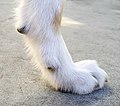Comparative foot morphology
Comparative foot morphology involves the study of the structure, function, and evolutionary differences in the feet of various species. This field encompasses a broad range of disciplines including anatomy, physiology, evolutionary biology, and biomechanics. The morphology of the foot is crucial for understanding how different organisms move, interact with their environment, and how these features have evolved over time.
Overview
The foot is a complex structure that serves as the primary contact point with the ground for most terrestrial organisms. It is involved in supporting the body's weight, absorbing shock, and providing leverage for movement. In comparative foot morphology, the focus is on the differences and similarities in the foot structure across different species, including humans (Homo sapiens), other primates, birds (Aves), and other mammals.
Human Foot
The human foot is uniquely adapted for bipedal locomotion, featuring a longitudinal arch that provides shock absorption and efficiency in walking and running. The structure of the human foot includes 26 bones, 33 joints, and more than 100 muscles, tendons, and ligaments. Key components include the tarsal bones, metatarsal bones, and phalanges.
Primate Feet
Other primates, such as chimpanzees and gorillas, have feet more adapted for grasping and climbing. Their feet are more similar to human hands, with opposable big toes that allow for gripping branches. This feature is indicative of their arboreal lifestyle.
Avian Feet
Birds have a wide variety of foot types, each adapted to their unique lifestyle and environment. For example, eagles and hawks have powerful talons for grasping prey, while ducks and swans have webbed feet for swimming. The structure of bird feet is significantly different from that of mammals, with variations in the number of toes and their orientation.
Mammalian Feet
Among mammals, foot morphology varies widely. Ungulates, for example, have evolved hooves that allow for efficient movement over hard ground. Carnivores like lions and wolves have claws and pads that aid in hunting and stealth. The diversity in mammalian foot morphology reflects the wide range of habitats and lifestyles.
Evolutionary Perspective
Comparative foot morphology provides insights into the evolutionary adaptations of different species. The structure of the foot can reveal a lot about an organism's evolutionary history, including its ancestors, lifestyle, and environmental adaptations. For example, the transition from arboreal to bipedal locomotion in early humans is a significant area of study within this field.
Conclusion
The study of comparative foot morphology offers valuable insights into the functional adaptations, evolutionary history, and ecological niches of various species. By understanding the differences and similarities in foot structure, scientists can gain a deeper understanding of the complex interactions between organisms and their environments.
Transform your life with W8MD's budget GLP-1 injections from $125.
W8MD offers a medical weight loss program to lose weight in Philadelphia. Our physician-supervised medical weight loss provides:
- Most insurances accepted or discounted self-pay rates. We will obtain insurance prior authorizations if needed.
- Generic GLP1 weight loss injections from $125 for the starting dose.
- Also offer prescription weight loss medications including Phentermine, Qsymia, Diethylpropion, Contrave etc.
NYC weight loss doctor appointments
Start your NYC weight loss journey today at our NYC medical weight loss and Philadelphia medical weight loss clinics.
- Call 718-946-5500 to lose weight in NYC or for medical weight loss in Philadelphia 215-676-2334.
- Tags:NYC medical weight loss, Philadelphia lose weight Zepbound NYC, Budget GLP1 weight loss injections, Wegovy Philadelphia, Wegovy NYC, Philadelphia medical weight loss, Brookly weight loss and Wegovy NYC
|
WikiMD's Wellness Encyclopedia |
| Let Food Be Thy Medicine Medicine Thy Food - Hippocrates |
Medical Disclaimer: WikiMD is not a substitute for professional medical advice. The information on WikiMD is provided as an information resource only, may be incorrect, outdated or misleading, and is not to be used or relied on for any diagnostic or treatment purposes. Please consult your health care provider before making any healthcare decisions or for guidance about a specific medical condition. WikiMD expressly disclaims responsibility, and shall have no liability, for any damages, loss, injury, or liability whatsoever suffered as a result of your reliance on the information contained in this site. By visiting this site you agree to the foregoing terms and conditions, which may from time to time be changed or supplemented by WikiMD. If you do not agree to the foregoing terms and conditions, you should not enter or use this site. See full disclaimer.
Credits:Most images are courtesy of Wikimedia commons, and templates, categories Wikipedia, licensed under CC BY SA or similar.
Contributors: Prab R. Tumpati, MD









